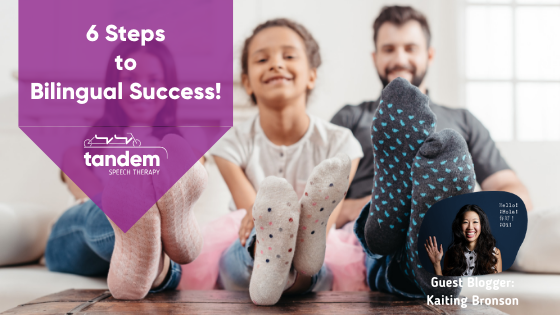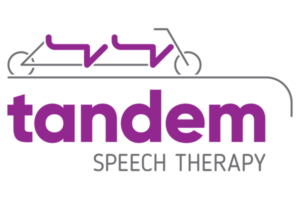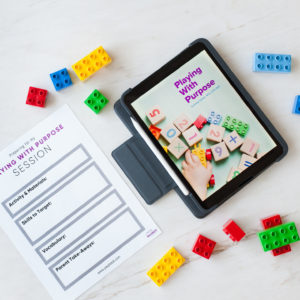
As a speech-language pathologist currently working in the US, I am often asked by parents if they should only speak English, as to not confuse their child. I reassure them that research shows whichever level a child can speak and understand in one language, they can speak and understand a second (or even third!) language to the same level. This is true regardless of whether the child is typically developing. For example, if a child can understand and speak English at a 5-year-old developmental level, given the same language exposure, they can reach a 5-year-old developmental level of Spanish, regardless of language delays.
It is a misconception that bilingualism is not achievable for children with language delays or that it confuses children. This misconception sometimes arises from a misunderstanding of the “silent period.” When children are processing the two different languages, they sometimes remain silent, focusing on listening before speaking. If you are concerned, find a speech-language pathologist that understands bilingual development in order to assess their development. However, it is beneficial to continue speaking to the child in both languages.
Here are some tips to provide a child with a supportive environment in which to become bilingual.
1. Model your stronger language. This provides your child with a stronger grammar model and more vocabulary words. Even if bilingual children initially know fewer words in one language, their vocabulary is typically at least as large as those of monolingual children when considering the number of words they know in both languages.
2. The One Parent One Language (OPOL) model is when one parent speaks to a child in only one language. For example, a mother would only speak and respond to their child in English, while the father would only respond and speak to their child in Spanish. Sometimes parents express concern to me that they attempt the OPOL model as much as possible, but when the entire family congregates, they can not maintain the OPOL model. Research has shown that does not negatively impact their bilingualism. It is a myth that it is the only way, but it is one great strategy!
3. Establish target language times. For example, you can decide that Monday, Wednesday, Friday are Mandarin days, and the rest of the days will be English days in your home. However, you don’t necessarily need to do it all day. You can alternate reading and bedtime stories, movies, playtime, mealtime, or model daily routines in the target language. Having visual support, such as a calendar or a simple paper with the word and cultural visuals of the language can help the child transition between language times. You can additionally support verbally by saying, for example, “Now it’s English time.” During reading times, be sure to find books with heroes of both cultures, which helps children feel cool about being bilingual! As different language books can sometimes be hard to find, narrating on your own by using wordless books is also beneficial.
4. During target language times, do not punish the child for codeswitching. Instead, respond to the child in the target language. Codeswitching is when a person alternates between multiple languages in the same conversation. This is a very normal result of bilingual development. In order to ensure accurate grammar and boost vocabulary, if your child code switches, simply respond to them in the target language. For example, If the child says “I want leche” during Spanish time, you can respond, “Quieres leche?” Or if they say, “I want to play la computadora,” during English time, you can respond, “After you eat, you can play on the computer.”

5. Use visuals in all languages around your house. Labeling frequently used words, in a different color for each language, helps to visually distinguish the languages. Furthermore, it promotes literacy and provides more exposure to the target vocabulary. An easy way to do this is by taping index cards or post-it notes around high-frequency objects or words around the house, such as rooms, furniture, a calendar, or favorite toys.
6. Talk with your child about the benefits of bilingualism. There are many cognitive benefits. Learning multiple languages at a younger age, aid in learning additional languages as an adult. It also increases cognitive functions such as improved ability to mentally transition between different tasks, higher attention to detail, and developing skills in conflict management. All the aforementioned can result in more job opportunities. There are social reasons too. I’ll give a personal example. My family is from Taiwan and my grandparents never learned English. I would’ve never been able to bond with my grandparents and some of my cousins if I hadn’t been taught Mandarin. Traveling the world as an adult, I’ve had many opportunities to make different types of friends and learn about different ways of life. It’s also empowered me to help lots more families as a speech-language pathologist.
Whatever choices you make for your family…we hope you find bilingual success!

Kaiting Bronson, M.S. CCC-SLP is a speech-language pathologist and the private practice owner of Primary Bilingual Therapies in Austin, TX. She received her Masters in Speech-Language Pathology at Columbia University. She speaks English and Mandarin natively, Spanish and Portuguese fluently, and is at beginner level in American Sign Language. She has worked as an SLP in a variety of settings in Austin, TX, New York City, NY, La Paz, Bolivia, and Accra, Ghana. Being a child of immigrants, growing up between 3 countries, she grew up observing the social isolation that results from communication struggles. From that experience, she became passionate about helping people learn to communicate and empower those that feel different to embrace their uniqueness.
Want to learn about the role parents play in their child's success?
Reference:
Paradis, J., Genesee, F., & Crago, M. B. (2011 ). Dual language development and disorders: A handbook on bilingualism & second language learning (2nd ed.). Baltimore, MD: Brookes.
Read our past blog posts about bilingualism:
Q and A: Raising a Bilingual Child
Introducing Your Family to a New Language
Start Playing With Purpose
Learn how to purposefully and intentionally interact with your child during play and help them increase opportunities for speech and language development with our Playing with Purpose book!










